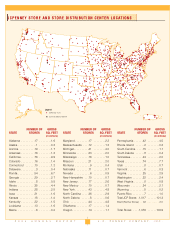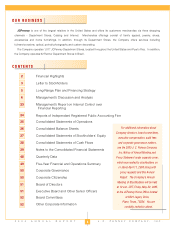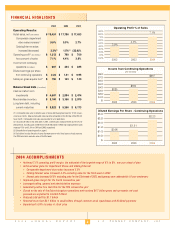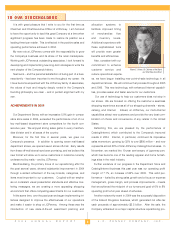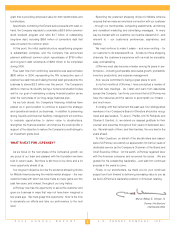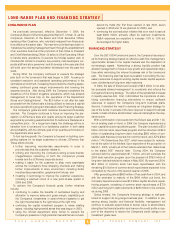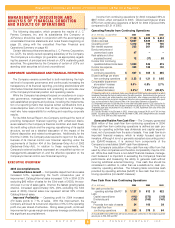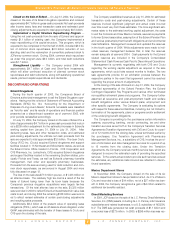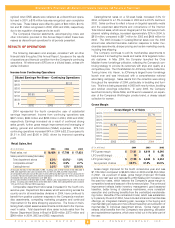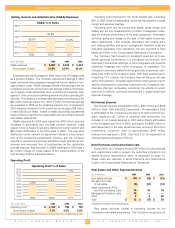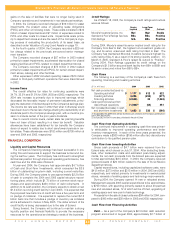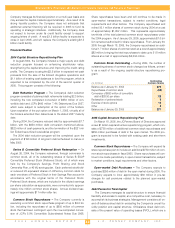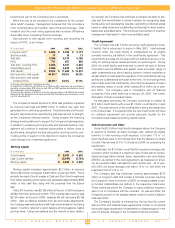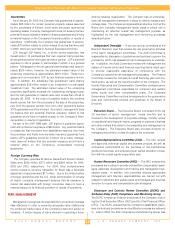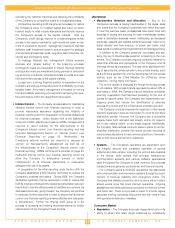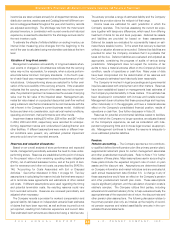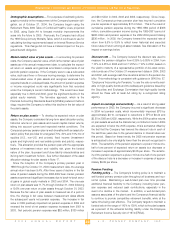JCPenney 2004 Annual Report Download - page 12
Download and view the complete annual report
Please find page 12 of the 2004 JCPenney annual report below. You can navigate through the pages in the report by either clicking on the pages listed below, or by using the keyword search tool below to find specific information within the annual report.
J.C. PENNEY COMPANY, INC.2 004 ANNUAL REPORT
Management’s Discussion and Analysis of Financial Condition and Results of Operations
10
gains on the sale of facilities that were no longer being used in
Company operations and investments in real estate partnerships.
In 2004, the Company recorded charges of $19 million for asset
impairments, the present value of operating lease obligations
(PVOL) and other unit closing costs. These costs consisted of $12
million of asset impairments and $7 million of expenses related to
PVOL and other costs for closed units. Impairments relate prima-
rily to department stores and are the result of the Company’s ongo-
ing process of evaluating the productivity of its asset base, as
described under Valuation of Long-Lived Assets on page 19.
In the fourth quarter of 2004, the Company recorded a $29 mil-
lion charge related to the previously announced senior manage-
ment transition.
The Company recorded charges of $57 million in 2003 related
primarily to asset impairments, accelerated depreciation for closed
catalog facilities and PVOL related to closed department stores.
The Company recorded charges of $75 million in 2002 related
primarily to asset impairments and PVOL for certain closed depart-
ment stores, catalog and other facilities.
Other expenses in 2002 included operating losses of $10 million
related to third-party fulfillment operations that were discontinued
in 2002.
Income Taxes
The overall effective tax rates for continuing operations were
34.7%, 33.2% and 31.5% for 2004, 2003 and 2002, respectively. The
2004 rate increase is primarily due to improved earnings, which
decreased the favorable impact of permanent adjustments, princi-
pally the deduction of dividends paid to the Company’s savings plan.
The income tax rate was lower in 2002 than what it otherwise would
have been due to the tax law change allowing the deductibility of all
dividends paid to the Company’s savings plan, with a one-time pro-
vision to include certain of the prior year’s dividends.
Due to current income levels, certain state tax planning benefits
have not been utilized, resulting in a lower tax benefit. Valuation
allowances have been established for tax benefits the Company
does not expect to realize due to short carryforward periods in cer-
tain states. These allowances were $102 million and $108 million at
year-end 2004 and 2003, respectively.
FINANCIAL CONDITION
Liquidity and Capital Resources
The Company’s financing strategy has been successful in pro-
viding time and resources to support the business turnaround dur-
ing the last four years. The Company has continued to strengthen
its financial position through improved operating performance, free
cash flow and the 2004 sale of Eckerd.
At year-end 2004, the Company had approximately $4.7 billion
of Cash and Short-Term Investments, which exceeded the $3.9
billion of outstanding long-term debt, including current maturities.
During 2005, the Company plans to use approximately $2.2 billion
of cash to complete the 2004 and 2005 capital structure reposi-
tioning plans, which include $1.75 billion of common stock repur-
chases and approximately $450 million of debt retirements. In
addition to its cash position, the Company expects to obtain a new
$1.2 billion revolving credit facility in April 2005. It is expected that
the proposed new bank line of credit will have a five-year term and
no pledge of collateral. It is expected to replace the current $1.5
billion bank line that includes a pledge of inventory as collateral
and is scheduled to mature in May 2005. The dollar amount of the
credit facility is being decreased due to the sale of Eckerd.
Going forward, the Company will continue to maintain a strong
liquidity position and financial flexibility to provide the necessary
resources for the operational and strategic needs of the business.
Credit Ratings
As of March 18, 2005, the Company’s credit ratings and outlook
were as follows:
Senior Long-Term
Implied Debt Outlook
Moody’s Investors Service, Inc.
Ba1 Ba2 Stable
Standard & Poor’s Ratings Services
BB+ BB+ Positive
Fitch Ratings
N/A BB+ Positive
During 2004, Moody’s raised its senior implied credit rating for the
Company from Ba2 to Ba1, the highest non-investment grade rat-
ing, and its senior unsecured debt rating from Ba3 to Ba2. The
Company has maintained Moody’s Investors Service’s highest liq-
uidity rating (SGL-1) as a result of its strong liquidity position. On
March 8, 2005, Standard & Poor’s raised its outlook to “Positive.”
During 2004, Fitch Ratings upgraded its credit ratings on the
Company’s $1.5 billion secured bank facility from BB+ to BBB- and
its senior unsecured notes from BB to BB+.
Cash Flows
The following is a summary of the Company’s cash flows from
operating, financing and investing activities:
($ in millions)
2004 2003 2002
Net cash provided by/(used in):
Operating activities(1)
$ 1,127 $ 812 $ 522
Investing activities
4,288 (253) (277)
Financing activities
(2,656) 25 (1,062)
Cash (paid to)/received from
discontinued operations
(1,066)(2) (64) 451
Net increase/(decrease) in cash
and short-term investments
$ 1,693 $ 520 $ (366)
(1) Includes $300 million ($190 million after tax) discretionary cash contributions to the Company’s qualified pension
plan in 2004, 2003 and 2002.
(2) Includes $822 million of income taxes paid related to the sale of Eckerd.
Cash Flow from Operating Activities
The continued improvement in operating cash flow was primari-
ly attributable to improved operating performance and better
inventory management. In each of the three years presented, the
Company made a $300 million ($190 million after tax) discretionary
contribution to its qualified pension plan.
Cash Flow from Investing Activities
Gross cash proceeds of $4.7 billion were received from the
Eckerd sale, which closed on July 31, 2004. After deducting taxes,
fees, other transaction costs and estimated post-closing adjust-
ments, the net cash proceeds from the Eckerd sale are expected
to total approximately $3.5 billion. In 2003, the Company received
gross proceeds of $20 million related to the sale of its six Mexico
department stores.
Capital expenditures, including capitalized software costs, were
$412 million, $373 million and $315 million in 2004, 2003 and 2002,
respectively, and related primarily to investments in new/relocated
stores, renewals of existing space and technology improvements.
During 2004, the Company opened 14 new or relocated stores.
Management expects 2005 capital expenditures to be approximate-
ly $700 million, with spending primarily related to about 20 planned
new and relocated stores, 12 of which will be off-mall, upgrading of
existing space and new point-of-sale technology.
Proceeds from the sale of closed units were $34 million for 2004, com-
pared to $100 million and $38 million in 2003 and 2002, respectively.
Cash Flow from Financing Activities
Debt
—As a part of the Company’s $2.3 billion debt reduction
program announced in August 2004, approximately $1.7 billion of


